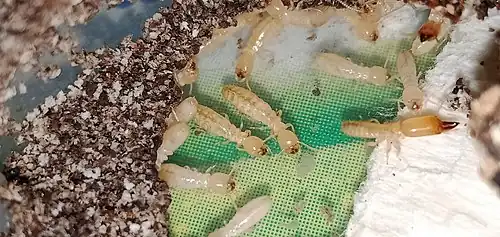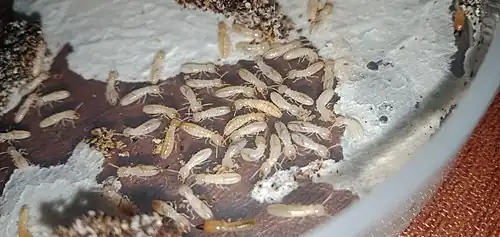Heterotermes
Heterotermes is a genus of termites belonging to the family Rhinotermitidae.[1]
| Heterotermes | |
|---|---|
| Scientific classification | |
| Domain: | Eukaryota |
| Kingdom: | Animalia |
| Phylum: | Arthropoda |
| Class: | Insecta |
| Order: | Blattodea |
| Infraorder: | Isoptera |
| Family: | Rhinotermitidae |
| Genus: | Heterotermes Froggatt, 1896 |
The genus has almost cosmopolitan distribution.[1]
General overview
Heterotermes is a termite genus from the Rhinotermitidae Family. One of their closest relatives is Reticulitermes. And like its relative, some Heterotermes have also been considered pests because they form pretty large colonies; to feed all their members, they need food in massive amounts. Therefore, Heterotermes try to feed themselves by gathering cellulose food from dead tree logs, stumps, and branches, to man-made wooden structures in buildings, books, paper, etc.
Heterotermes are also one of the most adaptive termites around, and they have a relatively fast growth rate in mature colonies if they have the perfect conditions to thrive. They can be found in very dry areas and also somewhat humid areas with plenty of wood. One of the other adaptations in Heterotermes is the relatively fast Neotenic formation within the colony. Unlike Reticulitermes, who can form both Ergatoid neotenic and Nymphoid neotenic reproductives, Heterotermes is only observed to have the Nymphoid neotenic caste as a secondary reproductive.
Heterotermes are very similar looking to Reticulitermes. But this soldier caste in Heterotermes is smaller than the soldier in Reticulitermes. And unlike Reticulitermes soldiers who have a curve in their mandible which starts from the base of the mandible, Heterotermes soldiers have a mandible with a curved tip, and the base area is straighter than Reticulitermes.
Castes
- Primary reproductive
The alates of many Heterotermes and Reticulitermes are very similar in morphology. But many Heterotermes gynes are more lightly pigmented (color range is usually pale yellow-brown to orange-brown) than Reticulitermes. They are mainly around 7mm-11mm in length. A colony usually consists of a pair of Primary reproductive, but is occasionally found having a few pairs.

- Secondary reproductive
The only found type of secondary reproductive in Heterotermes is Nymphoid neotenic. They usually arise in case of colony isolation or the death of primary reproductive. They start to develop from around 3rd instar nymphs and but older nymphs are also found to molt back into a Nymphoid neotenic in case they are needed. A colony can have multiple Nymphoid neotenic pairs that get physogastric within the first few weeks to produce eggs. Similar to worker they lack visible eyes and are usually lightly pigmented giving a light orange-like tint.


- Workers and Soldiers
Workers build up the majority of a colony along with many soldiers. Workers perform tasks such as food gathering, nest expanding, care for reproductive and brood, while soldiers perform the task of defending intruders. The soldier will excrete a slightly grey-tinted sticky white liquid when disturbed and are also found to bump their heads into nest walls to alert fellow colony members about arriving danger.

Species
- Heterotermes aethiopicus (Sjöstedt, 1911)
- Heterotermes assu Constantino, 2000
- Heterotermes aureus (Snyder, 1920)
- Heterotermes balwanti Mathur & Chhotani, 1969
- Heterotermes brevicatena Watson & Miller, 1989
- Heterotermes cardini (Snyder, 1924)
- Heterotermes ceylonicus (Holmgren, 1911)
- Heterotermes convexinotatus (Snyder, 1924)
- Heterotermes crinitus (Emerson, 1924)
- Heterotermes eocenicus Engel, 2008
- Heterotermes ferox (Froggatt, 1898)
- Heterotermes gertrudae Roonwal, 1953
- Heterotermes indicola (Wasmann, 1902)
- Heterotermes intermedius Hill, 1932
- Heterotermes longicatena Watson & Miller, 1989
- Heterotermes longiceps (Snyder, 1924)
- Heterotermes maculatus Light, 1933
- Heterotermes malabaricus Snyder, 1933
- Heterotermes occiduus (Hill, 1927)
- Heterotermes omanae Chhotani, 1988
- Heterotermes pamatatensis Kemner, 1934
- Heterotermes paradoxus (Froggatt, 1898)
- Heterotermes perfidus (Silvestri, 1936)
- Heterotermes philippinensis (Light, 1921)
- Heterotermes platycephalus Froggatt, 1897
- Heterotermes primaevus Snyder, 1960
- Heterotermes sulcatus Mathews, 1977
- Heterotermes tenuior (Haviland, 1898)
- Heterotermes tenuis (Hagen, 1858)
- Heterotermes vagus (Hill, 1927)
- Heterotermes validus Hill, 1915
- Heterotermes wittmeri Chhotani & Bose, 1982
References
- "Heterotermes Froggatt, 1896". www.gbif.org. Retrieved 19 June 2021.